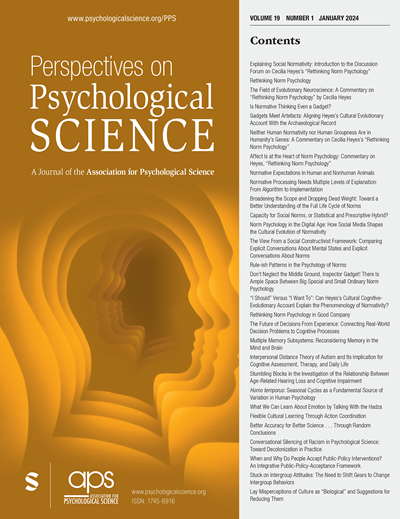少数族裔地位对跨种族效应的影响:一个批判性的回顾
IF 8.4
1区 心理学
Q1 PSYCHOLOGY, MULTIDISCIPLINARY
引用次数: 0
摘要
荟萃分析一致证明了跨种族效应(CRE;例如,同种族的面孔比不同种族的面孔更容易被识别)。这些分析揭示了与CRE相关的因变量在参与者和目标种族组合中的变化。然而,导致这些变化的潜在因素仍然知之甚少。我们认为,尽管CRE是稳健的,但其普遍性可能取决于所比较的特定种族群体,特别是在对比多数和少数种族群体时。在本文中,我们深入研究了不同种族群体的CRE动态,并探讨了少数民族种族地位如何影响研究成果。我们考虑了CRE最新荟萃分析中包含的文章,重点关注少数民族种族地位。我们认为,少数种族的地位可以解释为什么许多考虑非白人参与者的研究没有显示出CRE。CRE可能不像它看起来那么强大,因为大部分关于该效应的研究都集中在多数种族参与者和少数种族面孔上。展望未来,研究人员应该考虑纳入与少数族裔效应相关的措施,充分跨越参与者和目标种族,研究更多种类的种族。本文章由计算机程序翻译,如有差异,请以英文原文为准。
The Impact of Minority-Race Status on the Cross-Race Effect: A Critical Review
Meta-analyses have consistently demonstrated the robustness of the cross-race effect (CRE; i.e., better recognition of same-race faces compared with different-race faces). These analyses have unveiled variations in the dependent variables associated with the CRE across combinations of participant and target races. However, the underlying factors driving these variations remain poorly understood. We posit that although the CRE is robust, its generalizability may be contingent on the specific racial groups compared, particularly when contrasting majority and minority racial groups. In this article, we delve into the dynamics of the CRE across distinct racial groups and explore how minority-race status may influence research outcomes. We considered the articles included in the latest meta-analyses of the CRE with a spotlight on minority-race status. We suggest that minority-race status may explain why many studies considering non-White participants do not show a CRE. The CRE might not be as robust as it appears to be because much of the research on the effect has focused on majority-race participants and minority-race faces. Going forward, researchers should consider incorporating measures relevant to the minority effect, fully crossing participant and target races and studying a greater variety of races.
求助全文
通过发布文献求助,成功后即可免费获取论文全文。
去求助
来源期刊

Perspectives on Psychological Science
PSYCHOLOGY, MULTIDISCIPLINARY-
CiteScore
22.70
自引率
4.00%
发文量
111
期刊介绍:
Perspectives on Psychological Science is a journal that publishes a diverse range of articles and reports in the field of psychology. The journal includes broad integrative reviews, overviews of research programs, meta-analyses, theoretical statements, book reviews, and articles on various topics such as the philosophy of science and opinion pieces about major issues in the field. It also features autobiographical reflections of senior members of the field, occasional humorous essays and sketches, and even has a section for invited and submitted articles.
The impact of the journal can be seen through the reverberation of a 2009 article on correlative analyses commonly used in neuroimaging studies, which still influences the field. Additionally, a recent special issue of Perspectives, featuring prominent researchers discussing the "Next Big Questions in Psychology," is shaping the future trajectory of the discipline.
Perspectives on Psychological Science provides metrics that showcase the performance of the journal. However, the Association for Psychological Science, of which the journal is a signatory of DORA, recommends against using journal-based metrics for assessing individual scientist contributions, such as for hiring, promotion, or funding decisions. Therefore, the metrics provided by Perspectives on Psychological Science should only be used by those interested in evaluating the journal itself.
 求助内容:
求助内容: 应助结果提醒方式:
应助结果提醒方式:


